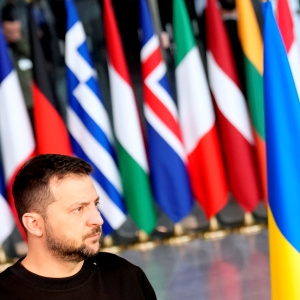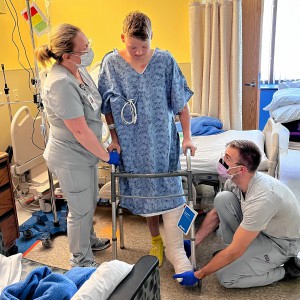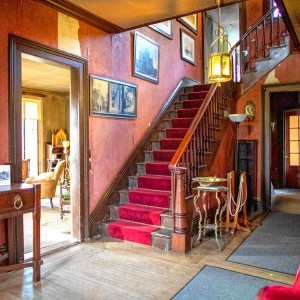Objects may be closer than they appear: Artist painted memories into 252 vintage car mirrors, on display at UMass’ Hampden Gallery through Dec. 1
| Published: 11-22-2023 6:05 PM |
Scottish multimedia artist Moray Hillary turns overlooked, ordinary details of everyday life into works of art.
His latest exhibition, “Selective Memory,” currently on display at the University of Massachusetts Amherst’s Hampden Gallery until Dec. 1, consists of 252 vintage Volkswagen Beetle car wing mirrors, each framing a miniature painting of a moment in time.
Most of the memories are Hillary’s own, based on reference photos he takes on his walk to his Glasgow studio every morning. Other memories are based on photos his friends send him, from Glasgow, Norway and New York. And some memories are stills taken from films and TV.
The inspiration, Hillary says, “was focusing on the overlooked — things that you see everyday but you take it for granted … We can’t remember everything that happens to us, and certain things stick out in your memory more than others — sometimes good, and sometimes bad.”
Hillary says he can remember the origins of each memory in the collection.
The project began nine years ago on a trip to Mexico when Hillary bought his first Volkswagen mirror. At the time, he wasn’t sure what he was going to do with it, so he kept it until he had a vision for the series four years ago.
He completed 90 paintings in 2020 alone.
“I start to think, ‘Oh, wow, this is going to be much bigger than I thought,’” Hillary said. He then set a goal to have 125 paintings completed for the series. When he reached that goal, he decided to shoot for 150.
Article continues after...
Yesterday's Most Read Articles
 Political newcomer defeats Shores Ness for Deerfield Selectboard seat
Political newcomer defeats Shores Ness for Deerfield Selectboard seat
 Granby Bow and Gun Club says stray bullets that hit homes in Belchertown did not come from its range
Granby Bow and Gun Club says stray bullets that hit homes in Belchertown did not come from its range
 Annette Pfannebecker: Vote yes for Shores Ness and for Deerfield
Annette Pfannebecker: Vote yes for Shores Ness and for Deerfield
 Susan Tracy: Support Ukraine funding
Susan Tracy: Support Ukraine funding
 Around Amherst: Bockelman joins in launch of governor’s housing push
Around Amherst: Bockelman joins in launch of governor’s housing push
 Defying the odds: Hadley’s Owen Earle back competing less than two years removed from horrific accident
Defying the odds: Hadley’s Owen Earle back competing less than two years removed from horrific accident
“And then I got to 150 and I thought, ‘I’m just going to go for 200.’ And then I got to 200 and I thought, ‘I’m just going to keep going!’”
The final number of paintings in the series is 255 — with three not displayed in the show as they are still in progress at his studio back home in Scotland.
“I try not to have as many gaps between bodies of work because those gaps can get really big,” Hillary said. “I think the more you leave it, the bigger the block becomes. Just keep doing it. And it keeps your brain moving — that’s why I’ve got three to do, because when I’m working on the last three, I’m thinking about a new project and not becoming stagnant and stuck.”
Hillary is already thinking about what he’s going to do next, with ideas involving creating large, free-standing retro-inspired billboards that advertise things that don’t exist, or having what he describes as a “hidden exhibition.”
“I like the idea of making paintings that you don’t really see when you first walk in — you have to look for them,” Hillary said. “It’s just the beginning of thoughts, still really early.”
Hillary’s artistic endeavors involve a range of mediums, materials and practices. For “Selective Memory,” he developed a way to make acrylic paint have the same appearance as oil paint, a medium he says he can no longer work with.
“I was making these huge paintings and experimenting with moving pigment around. So I was using buckets and buckets of substitute turps (turpentine, a solvent often used to thin oil-based paints) — not even real turps — and polyurethane varnish, and I started to get ill because of the fumes.”
Through experimentation, Hillary discovered a layering process to give acrylic paint an “oil effect.”
Every day he would complete a layer of the painting, then fossilize it by pouring a gloss medium on top that hid the brush marks. Each painting took about five days to complete, and would receive two layers of varnish every day. By the end, the paintings would have at least ten layers, giving the surface a thick and glassy finish.
“I don’t think it’s in an artist’s handbook,” Hillary said, laughing.
He first used this technique on a series of 25 faceless portraits that were exhibited by a curator in New York — who ultimately introduced him to another curator who connected him with Hampden Gallery and the UMass Fine Arts Center, which led to the creation of “Selective Memory.”
For Hillary, who admittedly does not enjoy networking, it was the perfect sequence of events.
“I love it,” Hillary said. “The way that it happened — that it was just really organic.”
“Selective Memory” has been six years in the making. The show’s original date was set for just before the pandemic struck.
The show is on display through Dec. 1. More information, including gallery hours, is available at http://tiny.cc/z2yevz.
Jesena Kalabokis is a student journalist at the University of Massachusetts Amherst. She can be reached at jesenakalabokis@gmail.com.





 A DIY approach to flying: Local pilots build and help build their own aircraft
A DIY approach to flying: Local pilots build and help build their own aircraft You’re up next: Western Mass open mic scene heats up post-pandemic
You’re up next: Western Mass open mic scene heats up post-pandemic One upon a story slam: This year’s Valley Voices winners head to a final competition
One upon a story slam: This year’s Valley Voices winners head to a final competition Preserving a key part of Emily Dickinson’s legacy: Historic Evergreens house reopens at the Emily Dickinson Museum
Preserving a key part of Emily Dickinson’s legacy: Historic Evergreens house reopens at the Emily Dickinson Museum